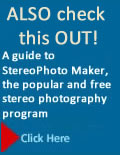|
Capturing Stereo Photographs

The Fuji 3D still cameras can capture HD stereo movies as well as stills. Dedicated 3D video cameras like this one from Panasonic are also available. These cameras capture stereo pairs that can be played back at 60 pairs a second for flicker free 3D.

The average distance between our eyes, known as the interocular distance, is 2.5 inches or 6.5 cm. To find the center to center distance between your eyes all you need is a ruler and a mirror. The distance for adults is normally between 54 to 70 mm and for kids between 41 to 55.
To capture a pair of stereo photos you use a camera with two lenses separated by approximately the average center-to-center distance between a pair of human eyes—about 2.5" (6.5 cm). If you don't have such a camera, you can use a
single lens camera as you'll see in Chapter 3.
Although the basic principles of stereo cameras haven't changed over the years, the media used to capture images certainly has. First used to capture Daguerreotypes, stereo cameras were later used to capture black and white and then color negatives on glass or film. These negatives were then used to make prints using a variety of processes—mainly albumen prints in the 19th century and silver prints in the 20th. There were even cameras designed to use transparency film to capture stereo slides—the most popular and well-known being View-Master reels and viewers. Now, in the 21st century stereo images are captured and processed digitally.

|

